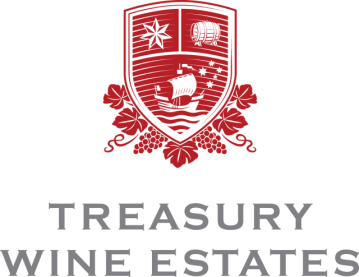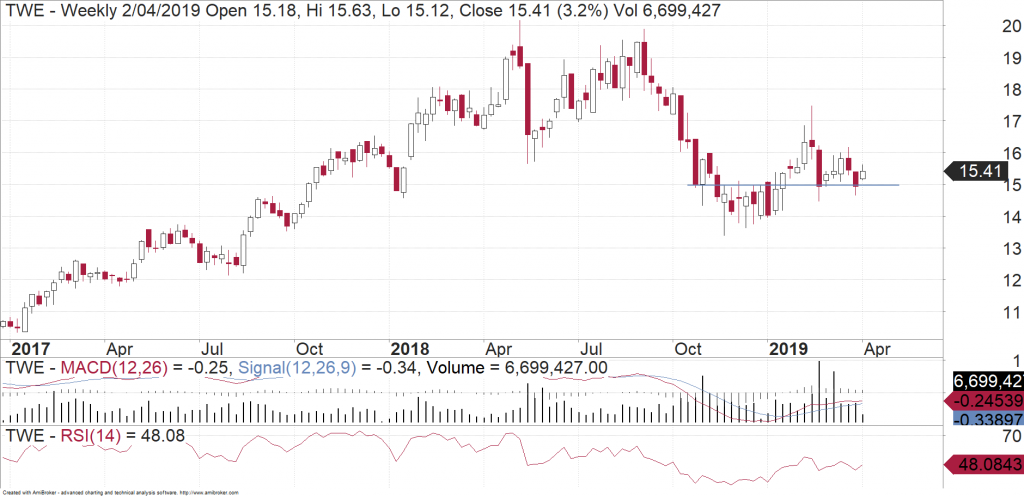The share price of Treasury Wine Estates (ASX:TWE) has tripled in the last 3 years. With most of their wines being sold into Asia and the US, what challenges lie ahead for the company? And do the charts indicate further upside for the share price?
About Treasury Wine Estates
The principal activities for Treasury Wine Estates include viticulture and winemaking, as well as the marketing, sale and distribution of wine. The Company has a wine portfolio of over 70 brands and operates in four regions: Americas (most notably the US), Australian & NZ, Asia and Europe. The brand portfolio is spread across the Luxury, Masstige (a term referring to Mass-produced Prestige wine) and Commercial price segments.
Guidance in Focus
We recently reviewed the Company’s interim results for the six months to 31 December 2018 (1H19), where the market’s focus was more on future guidance than the result itself.
Following a recent history of strong annual earnings growth over recent years, TWE has provided guidance for earnings growth of ~25% in FY19, as well as guidance for 15-20% growth in FY20. The Company has also indicated that it expects a higher rate of earnings growth in FY21 to accelerate (compared to the earnings guidance provided for FY20), due to the benefit of the larger and high-quality 2018 vintage, while there is optimism regarding FY22 due to the 2019 vintage in Australia and the US.
Most of the expected earnings growth target of 15-20% in FY20 is likely to be generated from the Americas division, where there are early signs distribution changes are working. While FY20 will contend with lower volumes from the 2017 vintage, the Company aim to offset this via the cost savings program. In addition, one-off transition costs relating to changes in the route-to-market in the US are being removed in 2H19, with margin accretion expected from FY20 onwards.
Expansion Plans in China: Opportunities and Risks
At the interim results release, TWE provided an overview of its operating model in China and the significant opportunity to continue to grow its market share by increasing the breadth and depth of its distribution footprint. While TWE is the largest wine importer in China, it only has a <5% share of the import market, after growing its share by ~30% over the last 12 months.
Uniquely combining both Fundamental and Technical Analysis
Not yet a subscriber? Join now for FREE!
Receive our weekly tips and strategies into your inbox each week.
BONUS: Sign up now to download our 21 page Trading Guide.
In context, China is estimated to account for over 50% of Asia division’s earnings, with divisional earnings growing by over 30% in 1H19. TWE uses a wholesale model in China, which eliminates the ~50% distributor margin typically incurred by its competitors. In turn, this creates a more efficient value chain, allows it to invest more heavily in its brands (lower price on shelf) and strengthen its retail partnerships. Under this wholesale model, TWE aims to expand city distribution coverage by +50% over the next three years.
The risk to this strategy is that TWE uses a number of 2nd tier distributors, who compete amongst each other as there are no firm distributor territories in China. Further, as these distributors are selling the same portfolio of TWE wines with a non-differentiated service, price is the key aspect of competition. Accordingly, this could lead:
i. Deep discounting among wholesalers and retailers in China for the Penfolds luxury range, particularly as there has been additional supply of Penfolds coming onto the market in FY19. In May 2018, there was evidence of over-supply of other TWE’s brands Rawson’s Retreat, Wolf Blass and some of the cheaper Berringer products, which resulted in deep discounting among wholesalers and retailers in China.
ii. Further weakness in cash conversion, as the portion of receivables outstanding increases. Weak cash conversion in 1H19 was weak, at 54%, which has led the Company to downgrade cash conversion guidance for FY19 to 60-70% (previously ~80%). However, long-term cash conversion guidance of ~80% was reiterated.
Fundamental View
While the shares are currently trading on a 1-year forward P/E multiple of ~21.5x, which is below the average multiple of ~25x over the last three years and at the lower end of a range of 21-30x over the same time frame, on balance, the potential for negative newsflow to impact the shares suggests a cautious view on TWE at current levels.
In addition to the expansion plans not being without risks, the performance of the Americas division will become more critical to TWE achieving its earnings growth guidance for FY20 and to this end, the magnitude of the margin expansion over the course of FY20/21 may disappoint given that firstly, TWE doesn’t have the same pull with distributors and retailers given it is a fraction of the size of the leading US wine makers like Constellation Brands, Gallo and The Wine Group. Secondly, the US wine market is more consolidated and competitive (in comparison to Asia) which limits all wine makers margins, in part due to the regulated nature of distribution in most states.
Charting View
TWE spend the end of of 2018 establishing some good support near $14. It then broke through the $15 resistance level earlier this year. However, in mid February it came crashing back down to the $15 level, which is now offering support. It hasn’t made much progress yet which is a slight concern. If we can see further evidence that TWE wants to hold above $15, then we can be confident that it won’t head any lower and that would be a buying opportunity. Otherwise if it breaches the $15 level, then investors can wait for prices closer to $14.

Michael Gable is managing director of Fairmont Equities.
Current share prices available here.
You can learn more about technical analysis in this article.
An 8-week FREE TRIAL to The Dynamic Investor can be found HERE.
Would you like us to call you when we have a great idea? Check out our services.
Disclaimer: The information in this article is general advice only. Read our full disclaimer HERE.
Like this article? Share it now on Facebook and Twitter!

